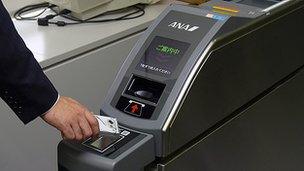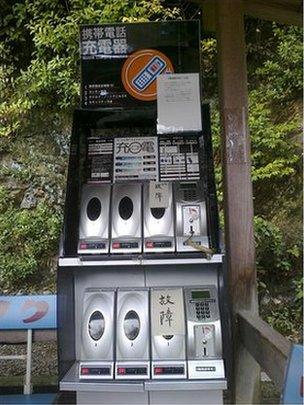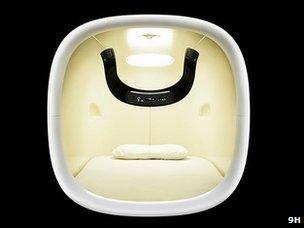Near field communication transforms travel in Japan
- Published

Mobile phones in Japan have been equipped with near field communication [NFC] technology for several years now
Ama Chan is aiming her mobile at small, square, printed, barcode tattoo that resembles a splattered space invader.
You will find their like plastered all over Japan. This one is printed on a Tokyo bus stop, so she clicks the camera shutter and peers happily at the result.
Her prize? A timetable appears instantly on the phone's screen, plus the estimated arrival time of the next bus.
When the oddly retro-style bus arrives, she uses her phone to pay by swiping at the front as a Londoner might flutter an Oyster smartcard on entering the Tube.
Ahead of the curve
This is travel Tokyo-style.
And although these types of convenient dodges are slowly appearing in the West (those information-laden barcode tattoos are known as QR codes in the UK, and e-wallets are appearing on phones outside Japan), the country has been experimenting with such technology for more than five years now, and more advanced travel guiding tech besides.

Japanese mobile phone - keitai - with NFC chip
So where better to examine the props that will dominate all our traveller and travel industry tomorrows?
Granted, an Anglo-Saxon smartphone, an iPhone, a Google phone and their ilk can be handy on the road but they lack, so far, many of the tools so useful to travellers in Japan on their so-called feature phones.
With the right clam-shell, iridescent "keitai", subscribers get a seriously high-resolution camera, a projector, and the all-important radio chip that works as a train/air/entrance ticket/boarding pass.
This radio tag can also check you into hotels and even open the room's door for you.
They also act as e-wallets. With up to 50,000 yen credit siphoned into the phone, customers use it to buy groceries at convenience stores, pay the taxi driver and persuade Japan's ubiquitous vending machines to cough up.
Flights of fancy
Japan's leading airline, All Nippon Airways (ANA), has been using such e-wallets to compete with the country's formidably fast trains for more than five years.
"The major drawback of flying compared to train travel is, of course, the time spent at the airport," says ANA spokesman Ryosei Nomura.
"With ANA's all-in-one ticket and boarding pass in your phone, you can arrive and board your plane within 15 minutes."
Dubbed SKiP, the service relies on Osaifu-Keitai (literally "wallet mobile") technology developed by comms giant NTT.

ANA passengers using their phone as a ticket can be on the plane within 15 minutes
As the NFC [near field communication] chip-based tech relies on dedicated readers which are available only in a few other countries besides Japan, the service so far applies just to domestic flights.
Users could even conceivably buy their air ticket using their phone at a convenience store with such readers.
The system has a number of advantages over plastic smart cards, too, such as being able to automatically recharge credit via the internet, says Mr Nomura.
With GPS in mobiles as standard, years ahead of the UK, the keitai has also evolved into a seriously useful navigation tool here.
Something called the Total Navigation site does exactly what it says on the tin, using 3D-rendered info on your screen. Hold it in your grip and the phone vibrates telling you when to turn.
Just as well: you need all the hand-holding you can get in the vastness of a capital without street names like Tokyo.
Deciphering menus
Tech also comes to the aid of the linguistically challenged.
Despite the cosmopolitan nature of Tokyo, menus are invariably in Japanese. So to have a phone that snaps a potential meal and describes in English what it is - mock-up meals are only sometimes displayed in the window - is obviously a godsend.
With some restaurant businesses this is catching on, as Japan looks to foreign tourists for badly needed revenue.
Other applications allow you to bring up menus, reviews and translations by other users just by focusing your mobile's camera at the restaurant itself.
Visitors to Japan can try out some of these services by renting domestic phones at the airports. Unfortunately, not all such resources are available on the airport pick-up phones.
But your correspondent was able to attempt a cashless journey from Tokyo through Kyoto to Fukuoka in the south starting with Ana's SKiP service for flights. No maps, no guides, just the omnipotent keitai.
The all-in-one nature of the mobile makes this possible, as does Japan's bent for convenience.
'Swiss army knife'
Such cramped, intensely urban, highly stressful lifestyles have made the Japanese super-reliant on, and worshipful, of convenience, says Ama Chan.
Keitai are the totems of that reverence and have become touchstones for survival. The keitai rules.

Public mobile-phone charging point on a Kyoto street
Travellers of the near future may want to emulate the light-footed Japanese, shearing off excess baggage such as guidebooks, laptops, camera - even books - and depending solely on the Swiss army knife of the road warrior - the keitai.
In Kyoto, the Hyatt Regency has started the ball rolling with an iPhone rental service that knows where guests are and beams text, video and graphics to inform, help and guide them.
"Of course many overseas visitors bring their smartphones with them, but most don't have a data plan that makes it economic sense to use their phone for downloads," says the hotel's manager Ken Yokoyama.
"The next step was to augment the service with tips from the concierge.
"After that we would like to develop a phone-based service that will think and act like a concierge, to give simple advice - where to eat, for example. The next step after that will be to totally personalise that service."
Mr Yokoyama envisages a massive database covering all Kyoto'a concierge knowledge melding into one serious, well-informed, location-specific travel application laid within the compass of the traveller's hand.
Real-world view
Augmenting city guides will not stop there. Something called "augmented reality" (AR) is already evolving into a valuable tool for travellers.

Augmented reality app Sekai Camera lets users hang "tags" that can be seen through an iPhone
Like the iPhone, such AR apps know where users are, and beam location relevant info to their phones. This is viewed superimposed on the camera viewfinder on the mobile's screen.
London already has Tube help in this form, while others such as Layar can perform the neat trick with restaurants, mentioned earlier.
Japan's version of this application, Sekai (World) camera, works the same magic, but adds tagging and social networking.
Like other AR apps it calculates your position, then using the camera, displays location-specific information graphically on top of your real-world view.
But the genius of Sekai Camera is that individuals and businesses can add their own information. They just point a smartphone camera at the landscape, adding "tags" that can include text, images, and sound that can be picked up by others in the area later.
Tags can translate into coupons from businesses (a free Guinness when you stop at a bar serving the black stuff, for example) or travel tips from friends.
Such apps are not just confined to Japan. They are available now at a smartphone near you.
But Japan still holds the lead with applications of tech for travel.
Overnight stay
The country's hotel industry is also benefiting from a dash of hi-tech gloss. Check into the entirely swish 9h (nine hours) capsule hotel in Kyoto and you might experience the teched-up future of budget hotels.

Guests at the 9h capsule hotel in Kyoto can relax in super hi-tech "pods"
Ultra-futuristic, the Kubrick-inspired pods go for about 4000 yen a night via their website.
Kyoto might be rich in heritage but this doesn't stop it over-dosing like the rest of urban Japan on hi-tech treats. For evidence, visitors might want to check out the phone chargers available in even the most venerable temples.
The futuristic travel experience that 9h offers (perhaps a model for a Mars trip accommodation?) includes a pod, not a bedroom, with a "Sleep Ambient Control System", that "lulls to a comfortable sleep". The same system awakens guests with light, not an alarm clock.
Spartan, functional, but fun for a night.
For sci-fi visions of how we might travel smarter in the future Japan obviously has plenty to show us. But the West is catching up fast.
Smartphones such as the iPhone and their apps are changing the way we travel, and how the travel industry attracts and aids such tourists.
Where most, outside of Japan, are still adjusting to life seen through the prism of the mobile, in Japan it is now second nature.
These early adopters are worth watching just to see how the tech will usher in new services for getting about and how to capitalise on our new-found travel touchstone - the mobile.